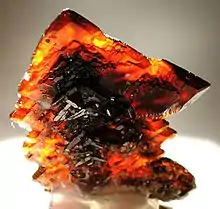| Descloizite | |
|---|---|
 Descloizite specimen from Berg Aukas (Berg Aukus), Namibia, 9.5 x 8.9 x 4.9 cm | |
| General | |
| Category | Vanadate mineral |
| Formula (repeating unit) | (Pb,Zn)2VO4OH |
| IMA symbol | Dcz[1] |
| Strunz classification | 8.BH.40 |
| Crystal system | Orthorhombic |
| Crystal class | Dipyramidal (mmm) H-M symbol: (2/m 2/m 2/m) |
| Space group | Pnma (no. 62) |
| Unit cell | a = 7.593, b = 6.057 c = 9.416 [Å]; Z = 4 |
| Identification | |
| Color | Brownish red, red-orange, reddish to blackish brown, nearly black |
| Crystal habit | Zoned tabular crystals common, encrustations and plumose aggregates |
| Cleavage | None |
| Fracture | Irregular, sub-conchoidal |
| Tenacity | Brittle |
| Mohs scale hardness | 3 - 3.5 |
| Luster | Greasy |
| Streak | Orange to brownish red |
| Diaphaneity | Transparent to opaque |
| Specific gravity | 6.1 - 6.2 |
| Optical properties | Biaxial (-) |
| Refractive index | nα = 2.185 nβ = 2.265 nγ = 2.350 |
| Birefringence | δ = 0.165 |
| Pleochroism | Visible |
| 2V angle | 85° to 90° |
| Dispersion | Strong r > v rarely r < v |
| References | [2][3][4] |
Descloizite is a rare mineral species consisting of basic lead and zinc vanadate, (Pb, Zn)2(OH)VO4, crystallizing in the orthorhombic crystal system and isomorphous with olivenite.[5] Appreciable gallium and germanium may also be incorporated into the crystal structure.
The color is deep cherry-red to brown or black, and the crystals are transparent or translucent with a greasy lustre; the streak is orange-yellow to brown; specific gravity 5.9 to 6.2; hardness 31/2. A variety known as cuprodescloizite is dull green in color; it contains a considerable amount of copper replacing zinc and some arsenic replacing vanadium.[5] There is also an arsenate analogue called arsendescloizite.[6]
Discovery and occurrence

It was discovered in the Sierra de Córdoba deposit in Córdoba, Argentina, in 1854 and named in honor of the French mineralogist Alfred Des Cloizeaux (1817–1897).[2] It occurs as small prismatic or pyramidal crystals, usually forming drusy crusts and stalactitic aggregates; also as fibrous encrusting masses with a mammillary surface.[5]
Descloizite occurs in oxidised portions of veins of lead ores in association with pyromorphite, vanadinite, wulfenite, mottramite, mimetite and cerussite.[4]
The Otavi ("O-tarvi") Mountainland of northern Namibia was once considered home to the greatest vanadium deposits in the world, including those at Berg Aukas ("OW-cuss"), Abenab ("UB-en-ub"), Baltika ("BUL-tika") and Uitsab ("ATE-sub").[7] Descloizite and mottramite were the main ore minerals in each of these deposits, which are now exhausted. Other localities are the Sierra de Cordoba in Argentina; Lake Valley in Sierra County, New Mexico; Arizona; Phoenixville in Pennsylvania and Obir, Carinthia Austria.
See also
References
- ↑ Warr, L.N. (2021). "IMA–CNMNC approved mineral symbols". Mineralogical Magazine. 85 (3): 291–320. Bibcode:2021MinM...85..291W. doi:10.1180/mgm.2021.43. S2CID 235729616.
- 1 2 Descloizite on Mindat.org
- ↑ Webmineral data
- 1 2 Handbook of Mineralogy
- 1 2 3 One or more of the preceding sentences incorporates text from a publication now in the public domain: Chisholm, Hugh, ed. (1911). "Descloizite". Encyclopædia Britannica. Vol. 8 (11th ed.). Cambridge University Press. p. 91.
- ↑ Arsendescloizite on Mindat.org
- ↑ Boni et al., 2007, Genesis of vanadium ores in the Otavi Mountainland, Namibia. Economic Geology v.102 p.441-469.